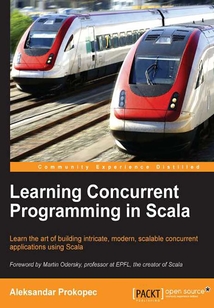舉報 

會員
Learning Concurrent Programming in Scala
最新章節:
Index
Thisbookisamust-havetutorialforsoftwaredevelopersaimingtowriteconcurrentprogramsinScala,orbroadentheirexistingknowledgeofconcurrency.ThisbookisintendedforScalaprogrammersthathavenopriorknowledgeaboutconcurrentprogramming,aswellasthoseseekingtobroadentheirexistingknowledgeaboutconcurrency.BasicknowledgeoftheScalaprogramminglanguagewillbehelpful.Readerswithasolidknowledgeinanotherprogramminglanguage,suchasJava,shouldfindthisbookeasilyaccessible.
目錄(84章)
倒序
- 封面
- 版權頁
- Credits
- Foreword
- About the Author
- Acknowledgments
- About the Reviewers
- www.PacktPub.com
- Support files eBooks discount offers and more
- Preface
- How this book is organized
- What this book covers
- What you need for this book
- Who this book is for
- Conventions
- Reader feedback
- Customer support
- Chapter 1. Introduction
- Concurrent programming
- The advantages of Scala
- Preliminaries
- Summary
- Exercises
- Chapter 2. Concurrency on the JVM and the Java Memory Model
- Processes and Threads
- Monitors and synchronization
- Volatile variables
- The Java Memory Model
- Summary
- Exercises
- Chapter 3. Traditional Building Blocks of Concurrency
- The Executor and ExecutionContext objects
- Atomic primitives
- Lazy values
- Concurrent collections
- Creating and handling processes
- Summary
- Exercises
- Chapter 4. Asynchronous Programming with Futures and Promises
- Futures
- Promises
- Futures and blocking
- The Scala Async library
- Alternative Future frameworks
- Summary
- Exercises
- Chapter 5. Data-Parallel Collections
- Scala collections in a nutshell
- Using parallel collections
- Caveats of parallel collections
- Using parallel and concurrent collections together
- Implementing custom parallel collections
- Alternative data-parallel frameworks
- Summary
- Exercises
- Chapter 6. Concurrent Programming with Reactive Extensions
- Creating Observable objects
- Composing Observable objects
- Rx schedulers
- Subjects and top-down reactive programming
- Summary
- Exercises
- Chapter 7. Software Transactional Memory
- The trouble with atomic variables
- Using Software Transactional Memory
- Composing transactions
- Retrying transactions
- Transactional collections
- Summary
- Exercises
- Chapter 8. Actors
- Working with actors
- Communication between actors
- Actor supervision
- Remote actors
- Summary
- Exercises
- Chapter 9. Concurrency in Practice
- Choosing the right tools for the job
- Putting it all together – a remote file browser
- Debugging concurrent programs
- Summary
- Exercises
- Index 更新時間:2021-08-05 17:08:31
推薦閱讀
- WildFly:New Features
- Mastering matplotlib
- C++程序設計基礎教程
- OpenShift在企業中的實踐:PaaS DevOps微服務(第2版)
- Mathematica Data Analysis
- R Data Analysis Cookbook(Second Edition)
- Visual C++開發入行真功夫
- C#程序設計教程(第3版)
- 移動互聯網軟件開發實驗指導
- Python語言科研繪圖與學術圖表繪制從入門到精通
- Zabbix Performance Tuning
- SQL Server 2012 數據庫應用教程(第3版)
- 大象:Thinking in UML(第二版)
- Continuous Integration,Delivery,and Deployment
- Java程序設計基礎教程
- 中小企業網站建設與管理(靜態篇)
- 數據分析從入門到進階
- Pentaho Analytics for MongoDB Cookbook
- Abaqus GUI程序開發指南(Python語言)
- AVR單片機C語言非常入門與視頻演練
- 深入理解JVM字節碼
- 股票多因子模型實戰:Python核心代碼解析
- 劍指JavaScript:核心原理與應用實踐
- Unity 3D從入門到精通(視頻微課版)
- Java應用開發:基礎知識
- 代碼之外的功夫:程序員精進之路
- Python+Excel職場辦公數據分析
- Maven Essentials
- Java 9 High Performance
- Vagrant開發運維實戰

